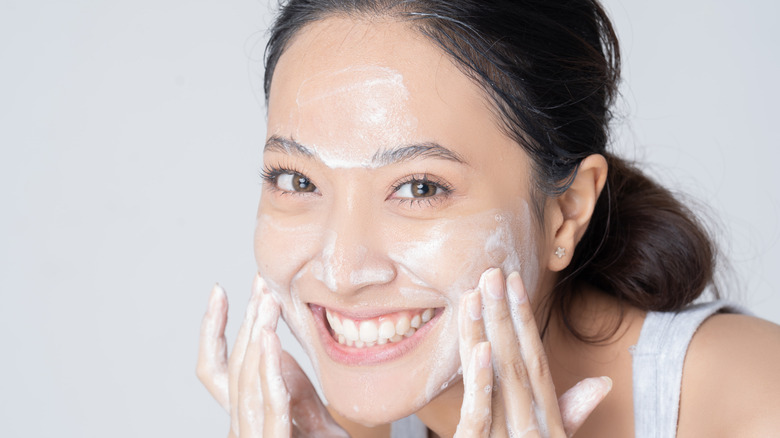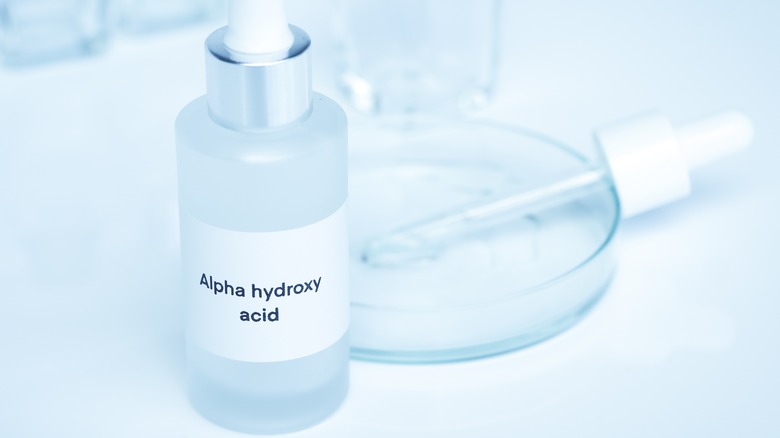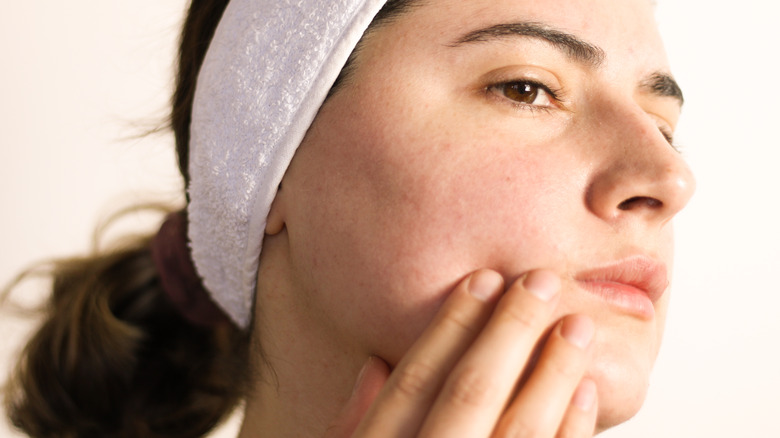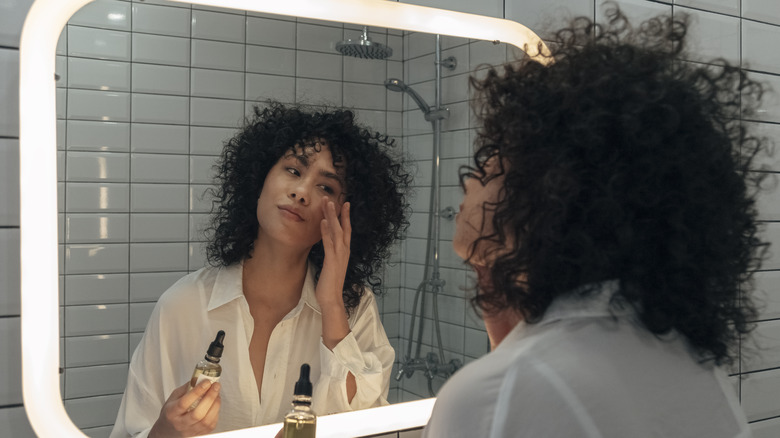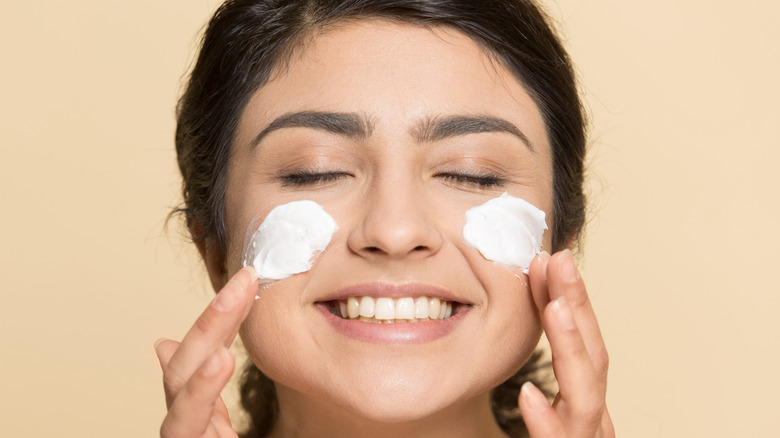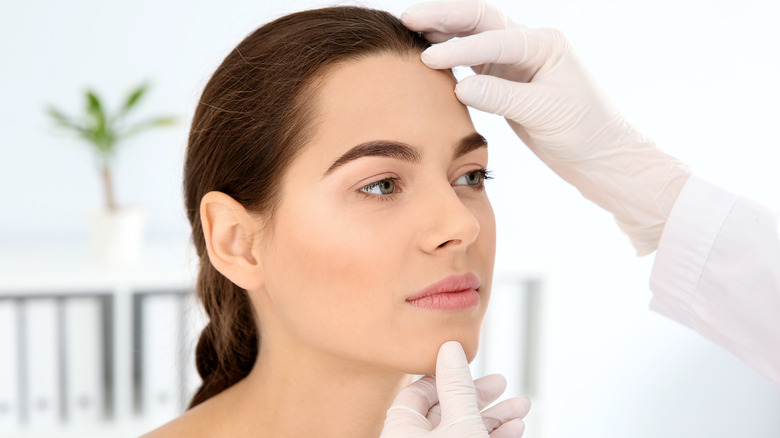How To Choose The Best AHA For Your Skin Type And Skincare Needs
There is a lot of conversation around alpha hydroxy acids (also known as AHAs) in the beauty world, from how AHAs differ from other types of acids used as ingredients in skincare products to which other skincare ingredients shouldn't be used in combination with AHAs. The amount of information out there — and especially online — can seem overwhelming, especially if you're new to using AHAs or are just getting started with a more serious skincare routine.
Once you have decided to incorporate an AHA into your routine, the next question becomes figuring out which one is right for you, your skin type, and what you're looking to get out of using an AHA. Per Healthline, there are actually seven different AHAs that are used most often as skincare ingredients, and that's a lot to keep track of. To help you out, we've broken down what you need to know when it comes to choosing an AHA.
Not all alpha hydroxy acids are vegan
While our first point isn't directly related to your skin type, it is related to one element of alpha hydroxy acids (AHAs) that might narrow down which ones you want to use on your skin by default: Not all AHAs are necessarily vegan, so it's important to look into the ingredients of any products you use to determine from what sources they have been derived. For example, Healthline notes that hydroxycaproic acid comes from royal jelly, which is a substance made by bees; hydroxycaprylic acid comes from animal sources; and lactic acid can come from lactose, which is found in milk.
If the origins of these AHAs are concerning for you, you might want to look into some of the other AHAs as alternatives, or you might want to choose a different type of skincare ingredient. Some vegan skincare brands offer products including AHAs, so you also could look into those products more specifically.
Alpha hydroxy acids can be irritating
One of the downsides to using alpha hydroxy acids (AHAs) in general is that they can irritate your skin, although they are less likely to do so than beta hydroxy acids (BHAs). In fact, dermatologist Rachel Nazarian explained to Byrdie, "Everyone should be diligent in finding the right concentration and right combination of AHAs for their skin type. Overuse, or using a concentration that's too high, can lead to irritated and inflamed skin and can flare other underlying conditions such as rosacea and eczema."
Especially if you know that your skin is prone to these conditions, this could be an indication that you're better off using a milder AHA. (In this regard, Healthline suggests using malic acid, which is actually a combination AHA and BHA.) Additionally, Healthline writes that using any AHA will make your skin more sensitive to sunlight, which you should also keep in mind when adjusting your skincare routine.
One alpha hydroxy acid is best for dry skin
Although alpha hydroxy acids (AHAs) are viewed as being better for dry skin than oily skin (which is better served by BHAs) in general, it turns out that there is one AHA that stands out among the rest when it comes to treating dry skin itself. That AHA is a relatively common one, and it's none other than lactic acid. According to beauty therapist Lisa Kordecki's comments to Stylist, lactic acid is distinct from other AHAs for one specific reason: "It's a powerful humectant, helping improve the skin's natural moisture barrier and hydration levels. This makes it ideal for dry or sensitive skin, alongside being a safe and effective ingredient for darker skin types too."
When speaking to NBC News, board-certified dermatologist Jessie Cheung additionally expressed a preference for lactic acid in skincare products over other AHAs, describing it as "more versatile, better tolerated and more hydrating than glycolic acid." Be sure to check out our guide if you're looking to learn even more about lactic acid in particular.
Two alpha hydroxy acids are best for balancing your skin's pH levels
Per Neutrogena's The Bar, there are two alpha hydroxy acids (AHAs) that you'll want to look into if you're trying to balance out your skin's pH levels. These AHAs are tartaric acid and citric acid, and Neutrogena notes that both of these are naturally found in fruits.
Dermatologist Karan Lal told Cosmopolitan that both tartaric acid and malic acid are the "least potent and the most gentle of the AHAs," so tartaric acid might be a better choice if you are concerned about the possibility of skin irritation from using an AHA.
Citric acid, on the other hand, has another benefit that its fellow AHA tartaric acid does not. Per Shape, it can actually get rid of impurities on your skin, a factor that prompted dermatologist Dennis Gross to comment to the publication, "Citric acid grabs onto these impurities so that they cannot enter your skin. I like to think of it as skin's Pac-Man."
Some alpha hydroxy acids should be used under the supervision of a dermatologist
If you're looking for a skincare routine that won't require visits to a dermatologist, some alpha hydroxy acids (AHAs) might be better choices for you than others. Citing the risk of sun sensitivity associated with them, dermatologist Rita Linker told NBC News that two AHAs in particular, glycolic acid and lactic acid, should be used with a dermatologist's supervision. (Linker also mentioned that glycolic acid is safe to use during pregnancy, which could be a factor that works in its favor for you.)
Similarly, RxList points out that the concentration of your products containing AHAs could affect whether or not you should be seeing a dermatologist while using them. If your product contains a 10% or higher concentration of an AHA, you should be using it under a dermatologist's supervision. RxList also mentions that malic acid may be safe to take orally, but we would suggest that this is something you should talk to your doctor about first.
